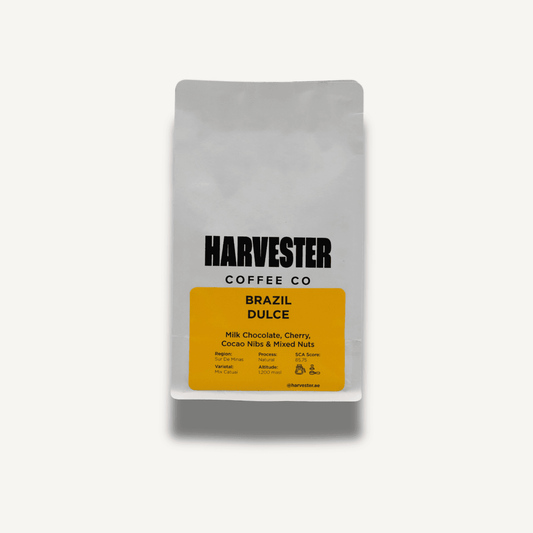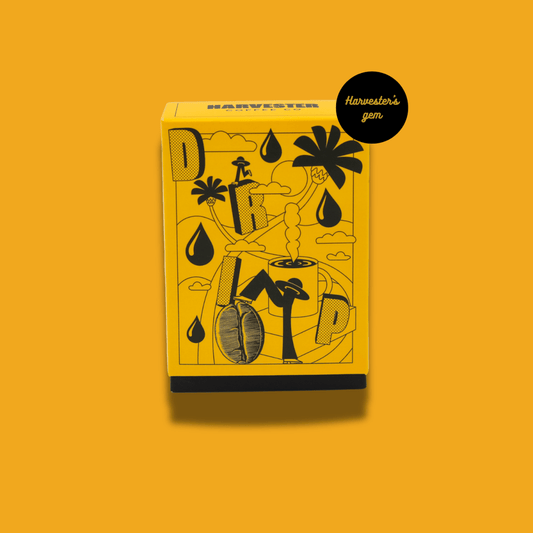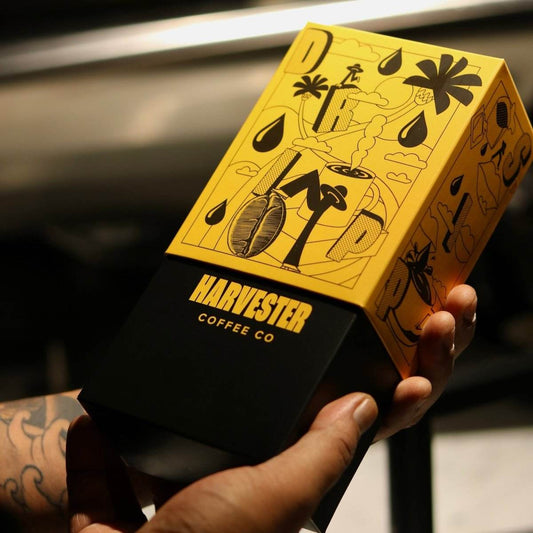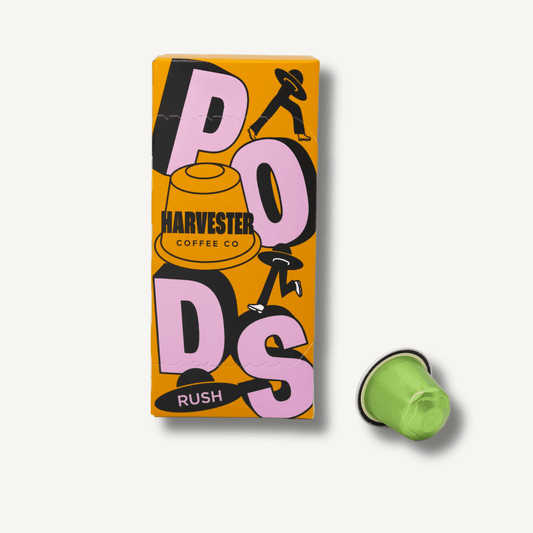Share
Picture the early morning mist rolling over the emerald mountains of Papua New Guinea. In remote highland villages, smallholder farmers hand-pick ripe coffee cherries from their backyard “coffee gardens,” just as the sun peeks over the horizon. These cherries, grown in mineral-rich volcanic soil at 1,400–1,800 meters above sea level (MASL), carry the story of Papua New Guinea’s unique terroir in every bean. Now, Harvester Coffee Company brings that story to your cup with our Papua New Guinea Smallholder Washed coffee – a single-origin offering that’s fully washed & wildly flavorful. Join us on a journey to explore how Papua New Guinea’s elevation, climate, and volcanic soil shape this coffee’s flavor, how village-based farming and the washed process contribute to its clarity and character, and what flavor notes await you (think dark fruit, brown sugar, and earthy spice). We’ll even share a brewing recommendation to help you savor every nuanced sip.
Highlands Terroir: Elevation, Climate & Volcanic Soil Magic
There’s a reason Papua New Guinea’s highlands are a paradise for coffee cultivation. The mountainous terrain of PNG’s interior provides high elevations (often 1.4–1.8 km above sea level) coupled with moderate tropical climates – conditions that slow down coffee bean maturation and yield dense, complex flavors. In these high altitudes, days are warm and nights are cool, a diurnal temperature swing that lets coffee cherries develop sweetness and depth over time. Meanwhile, the soil underfoot is literally born of volcanoes: rich, volcanic soil packed with minerals that coffee plants love. This fertile soil provides essential nutrients, nurturing the beans and contributing to the cup’s intense flavor complexity. Ample rainfall and lush rainforest canopy often surround the farms, further enhancing growth conditions in the highlands. The result of this ideal terroir is coffee that can be both vibrant and deep in flavor – a true reflection of Papua New Guinea’s land. It’s not uncommon for high-grown PNG coffees to exhibit a smooth medium body and a gentle acidity, with flavor nuances influenced by the rugged landscape and biodiversity of the region. In short, the high elevation, cool climate, and volcanic earth of Papua New Guinea team up to imbue our Smallholder Washed coffee with a distinctive “taste of place” in every sip.
Coffee Gardens & Community: Smallholder Farming in PNG
One of the most special aspects of Papua New Guinea coffee is who grows it and how. Unlike some origins dominated by large estates, over 85% of PNG’s coffee is produced by smallholder farmers tending tiny plots in village communities. These aren’t massive plantations, but rather family gardens – often called “coffee gardens” – where a household might have a few dozen or a few hundred coffee trees intercropped with food crops. In the highland provinces (like Western Highlands, Eastern Highlands, Simbu, etc.), thousands of individual farmers cultivate Arabica coffee as a cash crop alongside subsistence farming. Each smallholder typically lives off their land and cares for their coffee almost entirely by hand.
This village-based farming system means the coffee is truly a community effort. During harvest season (usually May to September in PNG’s main crop cycle), families will selectively hand-pick only the ripest red cherries – a labor-intensive process that ensures quality over quantity. With limited access to chemical fertilizers or pesticides, most of these small farms rely on organic practices by default, letting nature do the work. The care and intentionality of these farmers translate into beans of exceptional character. Each micro-lot reflects the specific village’s microclimate, the heirloom varieties grown (PNG coffee often descends from the Blue Mountain Typica introduced in the 1920s), and the hands-on methods of the farmers.
After picking, farmers usually bring their cherries to local processing stations or mills (since on-site processing infrastructure may be minimal). In our Smallholder Washed coffee’s case, multiple small farmers’ lots are combined at a central mill in the highlands, where quality control teams sort, pulp, ferment, and dry the beans. This cooperative approach maintains consistency and traceability – ensuring that only the best beans make it into each bag – while still preserving the unique character that each village’s harvest contributes. The result is a coffee born from community collaboration, with a story of livelihoods and traditions behind its flavor. When you drink it, you’re tasting the dedication of thousands of farmers and the vibrant tapestry of Papua New Guinea’s highland culture.
The Washed Process: Clean, Bright & Full of Character
Once the coffee cherries are harvested, how they’re processed can have a big impact on flavor. Harvester’s Papua New Guinea offering is a Fully Washed coffee, a processing method known for highlighting clarity and origin character in the cup. What does “washed” mean? In essence, it means the fruit pulp is removed from the coffee seeds (beans) before drying. At the mill, fresh cherries are run through a pulping machine to strip off the outer skin and most of the fruit flesh. The sticky beans (still coated in some mucilage) are then typically fermented in water for around a day, loosening any remaining fruit residue, and afterward thoroughly washed with clean water. Finally, the beans are dried (often sun-dried on raised beds or patios) until they reach a stable moisture level.
This wet-process sequence cleans the bean of nearly all fruit material, allowing the inherent flavors developed in the field (from the variety and terroir) to shine with minimal interference. Washed processing tends to produce a clean, bright flavor profile – you might notice a higher clarity of individual tasting notes and a crisper acidity compared to natural or dry-processed coffees. In Papua New Guinea, washed coffees are the norm (roughly 80–90% of PNG’s coffees are washed), and for good reason. The method suits the country’s coffee, bringing out its sweetness, delicate aromatics, and balance. Our Smallholder Washed lot went through careful washing at the community mill, which enhances its brightness and ensures that no off-flavors from uncontrolled fermentation taint the beans. What you taste is the pure character of high-altitude PNG coffee – vibrant yet clear flavors that can be traced back to the soil and climate, rather than the processing. For coffee lovers, this means you’ll experience the nuanced notes of this origin unmasked, with a transparent window into Papua New Guinea’s natural flavor profile.
It’s worth noting that washed processing also accentuates consistency: by fermenting and washing off the fruit, any overripe or funky flavors are washed away too. The end result in the cup is a bright, clean sweetness and a refined complexity that reflects both the careful processing and the quality of the harvest. In short, the fully washed method used for this coffee amplifies clarity and lets the terroir’s voice sing.

Flavor Profile: Dark Fruit, Brown Sugar, and Earthy Spice
So what does Papua New Guinea Smallholder Washed actually taste like? In a word: deliciously complex. This coffee offers a layered flavor experience that speaks to its origin. On the first sip, you’ll notice a rich sweetness reminiscent of caramelized sugar – think brown sugar or toffee notes that coat your palate with a smooth warmth. That sweetness is accompanied by a deep fruit backdrop. Some drinkers detect dark fruit nuances in the cup, like plum, raisin, or subtle dark berry tones. These fruit notes aren’t bright and citrusy; instead, they’re mellow and ripe, adding a winey depth (a nod to the coffee cherry’s fully developed sugars at that high elevation).
As the coffee cools slightly, its spicier side emerges. True to Papua New Guinea’s reputation, there’s an earthy spice undertone interwoven with the sweetness – imagine hints of nutmeg, clove, or an herbal sage-like note grounding the profile. In fact, PNG coffees are often noted for having spicy and earthy undertones beneath their sweetness, and our Smallholder lot is no exception. The spice is pleasant and aromatic, not overpowering; it adds a rustic, comforting dimension to the flavor. Some cups may also reveal a touch of cocoa or dark chocolate in the finish, enhancing that brown sugar sweetness with a bittersweet balance.
The overall profile is wonderfully balanced: a medium-bodied mouthfeel with a sweetness and fruitiness that’s tempered by gentle acidity and those warm spicy accents. Don’t expect the loud, floral fireworks of an Ethiopian coffee or the intense smokiness of a dark Sumatra; Papua New Guinea strikes a middle ground. It’s smooth and complex, with a flavor arc that might start out sweet and fruity and finish with an earthy, spicy linger on your tongue. The clarity from the washed process means you can pick out each of these notes as you sip – from the dark fruit hints to the brown-sugar sweetness and the whisper of spice – each flavor layer presents itself clearly, yet they harmonize in the cup. This coffee truly showcases the unique flavor spectrum that Papua New Guinea’s terroir can produce: jammy and sweet, yet grounded and hearty at the same time. We love it in the mornings for its comforting richness and in the afternoons for its intriguing complexity.
Brewing Recommendation: How to Enjoy It Best
To savor the full depth of this Papua New Guinea Smallholder Washed coffee, we recommend brewing it with a pour-over method. Hand-brewing methods like a Hario V60, Kalita Wave, or Chemex will highlight this coffee’s clarity and layered flavors. Using a paper filter in a pour-over will help emphasize the clean sweetness and bright notes that the washed process brings, allowing those dark fruit and brown sugar nuances to really shine through in the cup.
Brewing tips: Start with a medium grind (similar to coarse sand) and water around 200°F (93°C). A good coffee-to-water ratio is about 1:15 or 1:16 – for example, 20 grams of coffee to 300-320 grams of water. Rinse your filter, bloom the grounds with a bit of hot water for ~30 seconds, then slowly pour in stages. The total brew time should be around 3–4 minutes. This gentle extraction will draw out the coffee’s sweetness and complex notes without over-extracting the bitter elements. As you brew, you’ll notice the aroma of earthy spice and brown sugar wafting up – a little preview of the flavors to come.
Once brewed, take a moment to inhale the fragrance: you might catch a hint of spice in the aroma, almost like cinnamon stick or cedar, mingling with a molasses-like sweetness. On the sip, the pour-over method should deliver a cup that is crisp and clean, yet full-bodied enough to be satisfying. The acidity will be mild and balanced (some describe PNG’s acidity as “brandywine” or wine-like in its gentle tartness), which makes this coffee quite versatile.
If you prefer a heavier body and don’t mind a bit of sediment, this coffee also fares well in a French press – you’ll get a thicker mouthfeel and amplify the earthy, spicy notes (the French press’s metal filter won’t strip out the flavorful oils). However, for the first taste, we truly love the definition a pour-over provides for this origin.
No matter how you brew, one thing is certain: this Papua New Guinea Smallholder Washed coffee is a journey in a cup. From the volcanic highlands of PNG to your home brewing setup, it carries a sense of place that’s evident in its story and its taste. We invite you to brew a cup and experience the dark fruit sweetness, the brown sugar comfort, and the earthy spice twist for yourself. Enjoy the storytelling in each sip, and happy brewing!
In the end, Harvester’s Papua New Guinea Smallholder Washed isn’t just a coffee – it’s the product of terroir, tradition, and technique coming together. The high-altitude volcanic soils and rainforest climate of Papua New Guinea impart a one-of-a-kind character to these beans, the collective efforts of smallholder farmers give it a human touch and quality, and the washed processing method polishes it into a clean, bright cup. The flavor notes of dark fruits, caramel-like sweetness, and gentle spice make each cup an adventure for the palate, while still being incredibly approachable and comforting.
If you’re a coffee lover looking to explore new origins, Papua New Guinea is a hidden gem that offers something truly special – and we’re proud to share it with you. Brew it with care (perhaps in that V60 or your favorite dripper), and take a moment to appreciate the journey from a remote village garden in PNG to your mug. We hope this deep dive into the PNG Smallholder Washed has enriched your understanding and excitement. Now it’s time to taste the tale – happy sipping!












